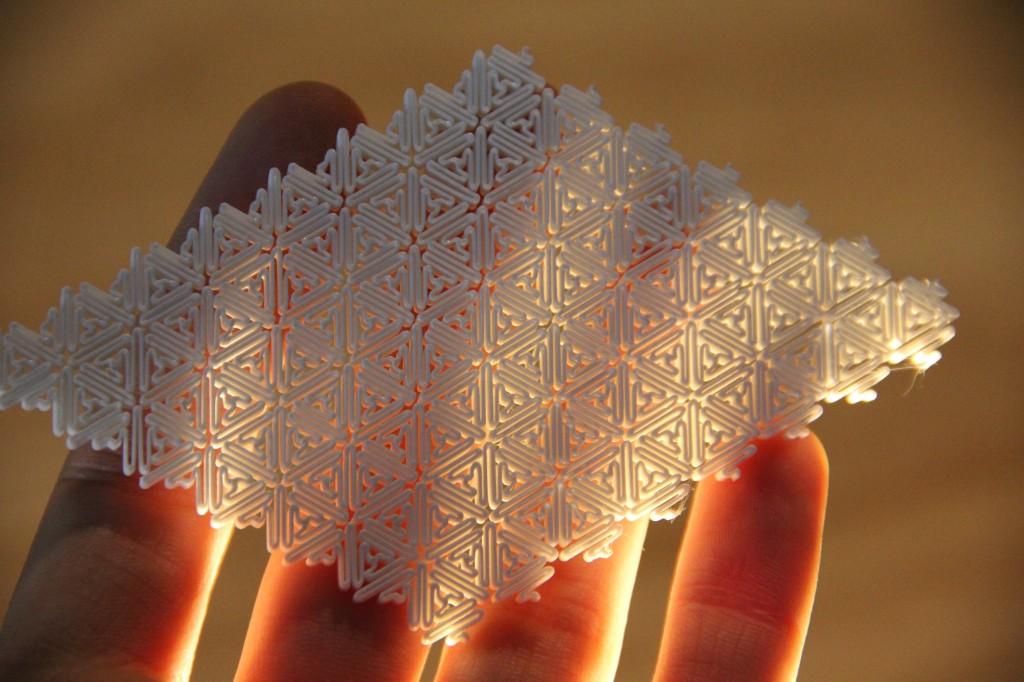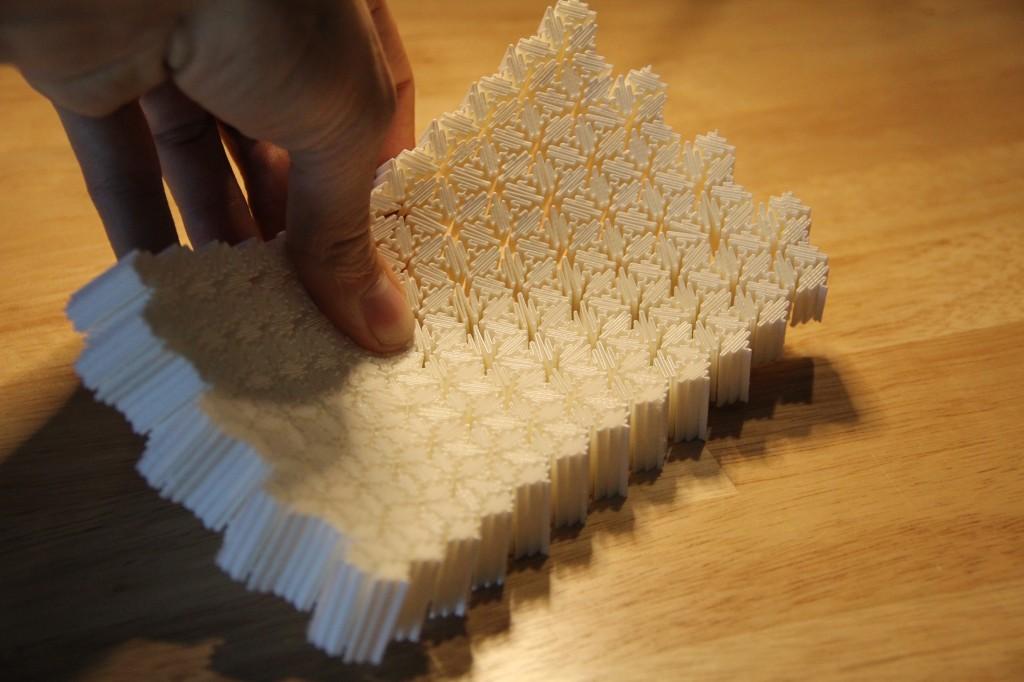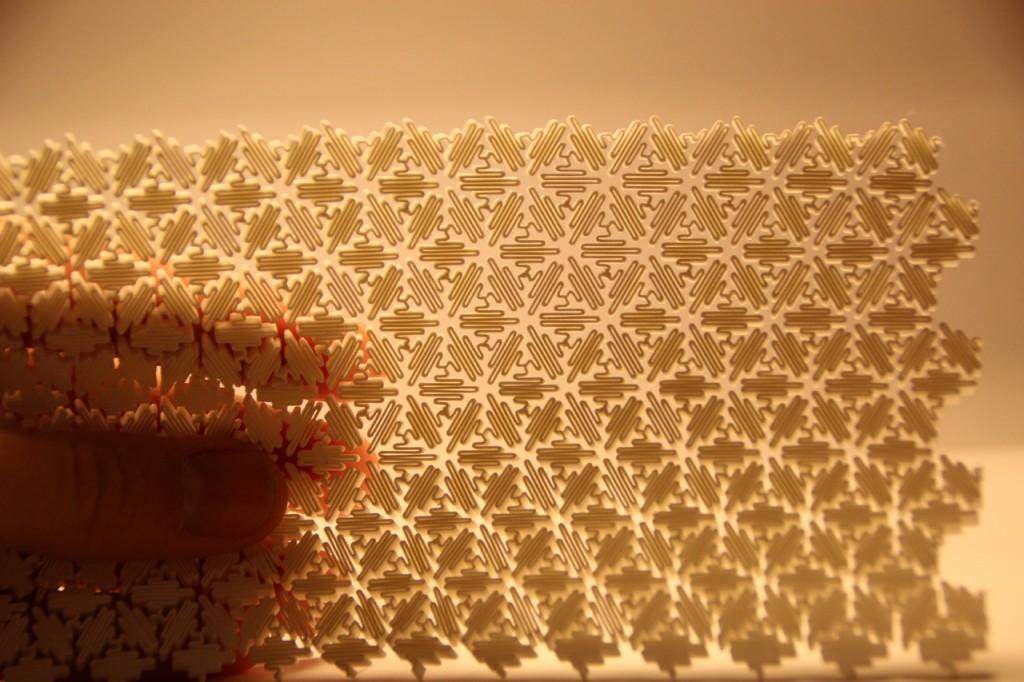 When it comes to designing and printing on 3D printers, the most common types of materials used are PLA and ABS plastics. These materials are sturdy, yet have a very difficult time bending and flexing. These plastics are simply not feasible for printing objects that need to bend, while still remaining strong. The same thing goes for many other materials, both 3D printed, and manufactured the traditional way. Metal, carbon fiber, other plastics, glass, and hundreds of other materials can run into these problems. Architecture, construction, automobile design, and just about every facet of our daily lives are limited by the fact that these materials are limited themselves in what they can do.
When it comes to designing and printing on 3D printers, the most common types of materials used are PLA and ABS plastics. These materials are sturdy, yet have a very difficult time bending and flexing. These plastics are simply not feasible for printing objects that need to bend, while still remaining strong. The same thing goes for many other materials, both 3D printed, and manufactured the traditional way. Metal, carbon fiber, other plastics, glass, and hundreds of other materials can run into these problems. Architecture, construction, automobile design, and just about every facet of our daily lives are limited by the fact that these materials are limited themselves in what they can do.
However, one man by the name of Andreas Bastian has come up with an incredible solution, which allows just about any material’s mechanical properties to be modified, so that they can take on more purpose in our daily lives. Imagine taking materials that traditionally do not bend, such as PLA or metal, and 3D printing them in such a fashion that these physical limitations no longer exist. Bastian refers to his “new” materials as “mesostructured material”.
The physical properties of the material themselves do not change, but the way in which the material is laid out does, allowing the physical aspects of the printed objects to take on new physical properties. For example, the same metal can be used to make a steel rod, as well as a steel spring. Both are made from the same material, but have different mechanical properties. One is stiff, while the other is bendy and bouncy. This is the premise that Bastian’s mesostructured materials are based on. Previously there have been products constructed that use polygonal meshes to make hard materials slightly more flexible. However, this was not good enough for Bastian. He believed that there was a better solution.
Currently architectural composites are used for building facades and outdoor sculptures. They use a honeycomb-like polygonal structure to give hard materials the ability to have some give and flexibility. However, there is very little added flexibility with these composite materials, and the architects remain restricted by the material’s mechanical properties. Composites are also used in aerospace and other structure applications. See below for an illustration of a typical composite panel using a honeycomb-like structure.
“I developed the geometry that composes my mesostructured materials, in response to the limitations of the deformability of regular polygonal meshes, whose vertices are connected by paths of minimal length (straight lines),” explained Andreas Bastian to 3DPrint.com in an interview. “I’d like to replace the honeycomb (see image above) with formed mesostructures to allow shapes more complex than flat panels to be fabricated.”
Bastian’s approach is to change the structure of the connective elements to increase their ability to stretch of compress, thereby increasing the bulk material’s deformability. His mesostructured material is not only extremely useful, but it is also quite breathtaking to look at.
“Architects could have much more flexibility in the variety of curved surfaces with which they could compose a building’s facade. Likewise, composite body panels used in boat hulls and automotive bodies could be fabricated using mesostructures as the core material, enabling more complex curvature. Current core materials are made using sheet lamination and expansion techniques that are great for mass production, but produce honeycomb core material that cannot be flexed without cell collapse in certain regions. Mesostructured cellular materials could allow for complex curvature in composite structures.”
It doesn’t end here though. Bastian believes that this type of material could also be used in fashion design, as well as home decor.
“When printed with softer, more flexible materials, [it] could have applications such as ‘digital textiles’ in fashion,” he explained. “I’m also really interested in using larger pieces of the mesostructured materials in light fixtures– as you can see from the pictures, there’s a lot of interesting options with how light passes through the structure.”
Bastian currently has been printing a plethora of Mesostructures on his FDM 3D printer. However, he is working on developing and building a custom 3D printer that is capable of printing these materials on a grander scale. The problem that he sees with conventional FDM machines is that they have a very limited build volume, which makes it impossible to fabricate large sections of these mesostructures. He is currently designing a 3D printer that includes one un-bounded build axis, which will allow objects of any length to be printed, similarly to how a loom produces bolts of cloth or a steel mill produces forged billets. The machine is almost complete, but not quite there yet.
Bastian is currently experimenting with many different materials, other than PLA and ABS.
“By changing the properties of the connective elements and the structure of the array that they populate, one can create pretty unique bulk mechanical properties,” he explained. “Additionally, bulk material properties can be changed by using different print materials, allowing for quite a bit of flexibility when it comes to designing the bulk material. Finally, while currently not possible on FDM machines, this idea of structuring matter via a networked component elements scales well to 3D.”
Check out the video below that Bastian made for us, showing different examples of this PLA printed mesostructured materials bending and deflecting light.
Andreas Bastian had worked in R&D at Makerbot for a year, before joining Jordan Miller’s lab at Rice University to develop low-cost SLS technology. He now designs and builds 3D printers as an artist in residence at Autodesk in San Francisco. While Bastian isn’t the first person to come up with these types of innovative ideas, he has really been one of the first to utilize 3D printing in this technique.
“After developing my structures, I learned that they fit into a broader field of research, that has been active for many years,” Bastian explained. “Carolyn Seepersad from UT Austin has done some very exciting work with similar structures. Additionally, the research and design firm Betatype is exploring the same ideas of crafting material function via material structuring, though they are using far more sophisticated tools to do this. ”
You can try and print out some of these mesostructured designs on your own 3D printer by downloading them on Thingiverse. What do you think would be some good uses of this material? Discuss this incredible new material in the mesostructured material thread on 3DPB.com
Subscribe to Our Email Newsletter
Stay up-to-date on all the latest news from the 3D printing industry and receive information and offers from third party vendors.
Print Services
Upload your 3D Models and get them printed quickly and efficiently.
You May Also Like
3D Printing News Briefs, July 2, 2025: Copper Alloys, Defense Manufacturing, & More
We’re starting off with metals in today’s 3D Printing News Briefs, as Farsoon has unveiled a large-scale AM solution for copper alloys, and Meltio used its wire-laser metal solution to...
Etsy Design Rule Change Reduces Selection of 3D Printed Goods
Online marketplace Etsy has implemented a rule change requiring all 3D printed goods on the site to be original designs. The update to the site’s Creativity Standards states, ¨Items produced using...
Siraya Tech Introduces New Elastomer 3D Printing Materials, Including Foaming TPU
California company Siraya Tech, founded in 2019 with a focus on material science, customer focus, and agility, develops high-quality 3D printing materials that meet the needs of creators, hobbyists, and...
3D Printing News Briefs, April 12, 2025: RAPID Roundup
The news from last week’s RAPID+TCT in Detroit just keeps on coming! That’s why today’s 3D Printing News Briefs is another RAPID Roundup of more exciting announcements from the trade...




































